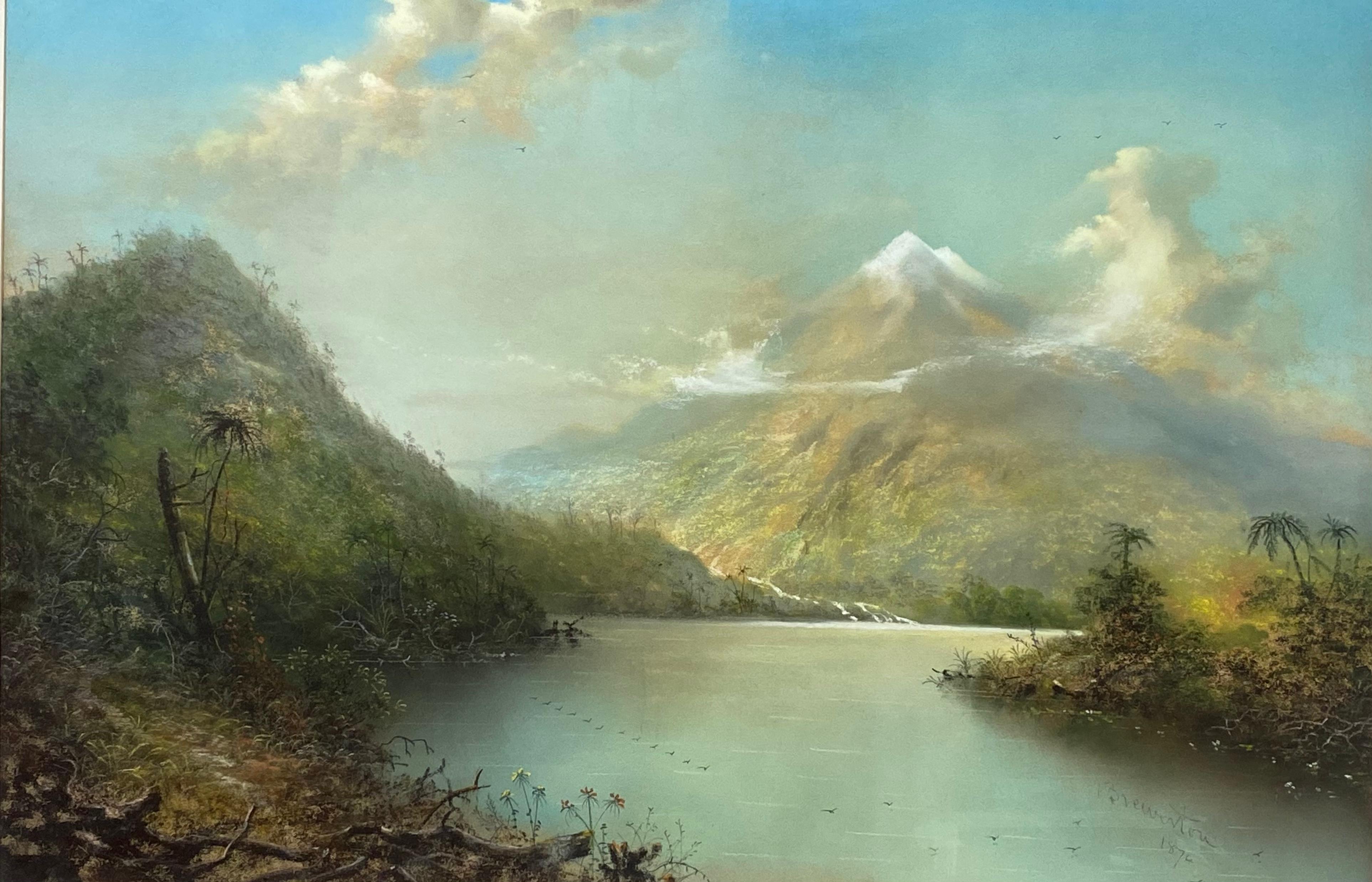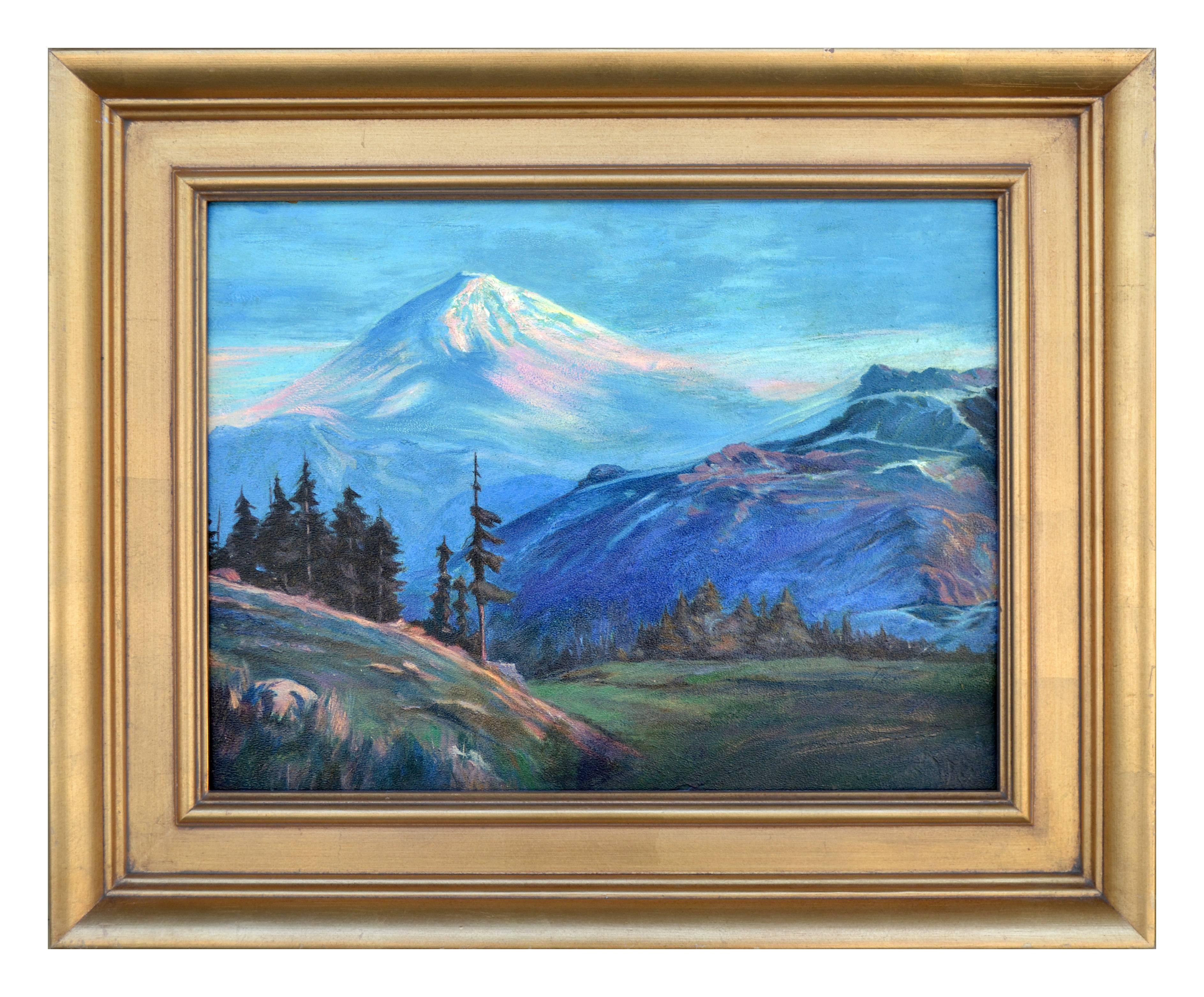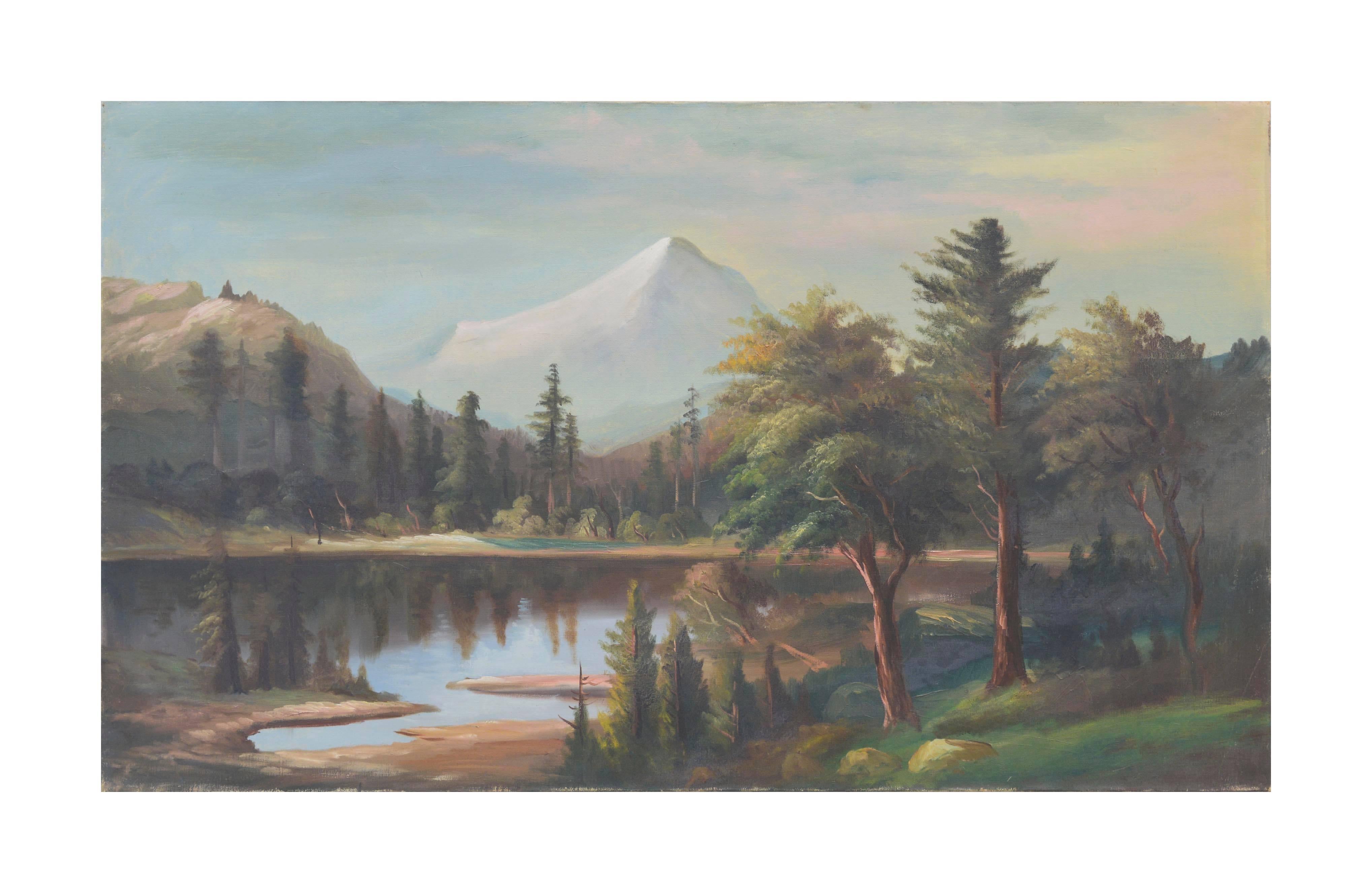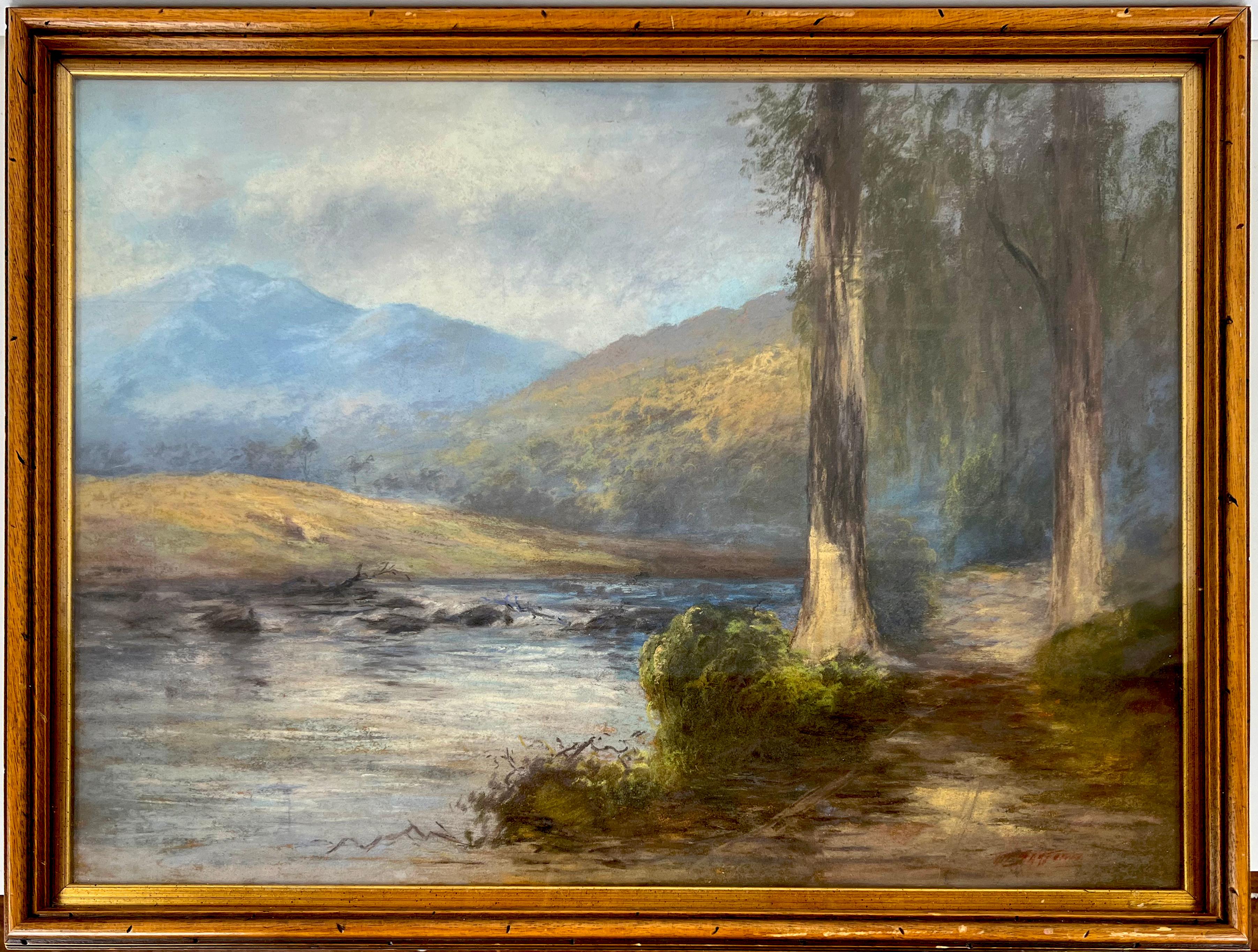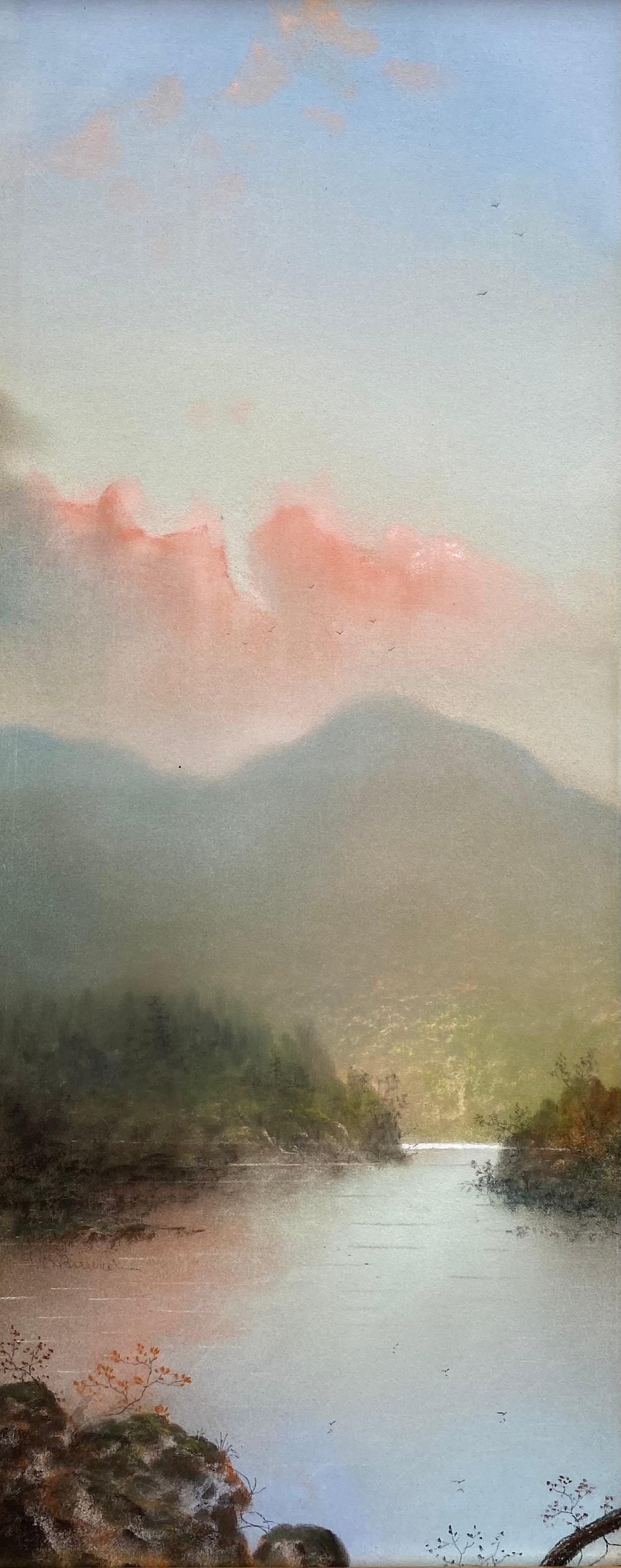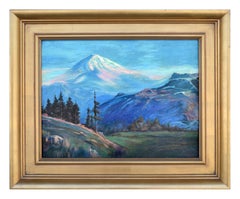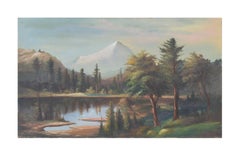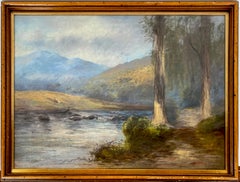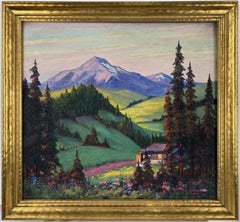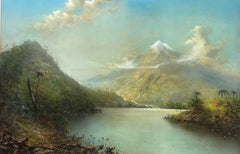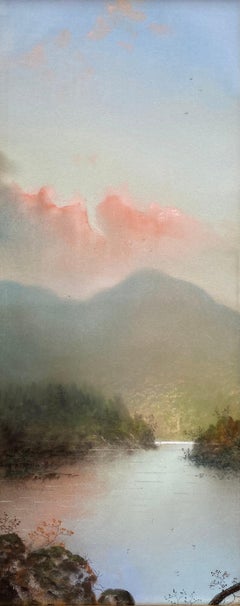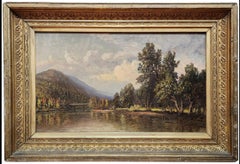Items Similar to Mt Shasta Spring Stroll on the River Beneath the Mountain Original Oil on Linen
Want more images or videos?
Request additional images or videos from the seller
1 of 13
John EnglehartMt Shasta Spring Stroll on the River Beneath the Mountain Original Oil on Linen1890s
1890s
$2,520
$3,50028% Off
£1,909.38
£2,651.9128% Off
€2,190.86
€3,042.8628% Off
CA$3,546.05
CA$4,925.0628% Off
A$3,898.08
A$5,41428% Off
CHF 2,048.65
CHF 2,845.3528% Off
MX$47,336.90
MX$65,745.6928% Off
NOK 25,556.43
NOK 35,495.0428% Off
SEK 24,212.92
SEK 33,629.0528% Off
DKK 16,350.94
DKK 22,709.6428% Off
About the Item
Mt Shasta Spring Stroll on the River Beneath the Mountain Original Oil on Linen
A solitary hiker on a trail with Northern California's Mt. Shasta in the distance by Joseph John Englehart (1867-1915), who was a prolific American landscape painter who painted in a realist style. He was born on June 14, 1867 in Chicago, Illinois, and died on April 14, 1915 in Oakland, California. He is noted for his documentation of America's Northwest Frontier at the turn of the 20th century, and for his oil paintings of landmarks such as Yosemite Valley, Mount Hood and Crater Lake. With most of his paintings he consistently avoided effets de soir, choosing the midday light over the romantic quality of lighting effects of sunrise or sunset.
Englehart worked under a number of pseudonyms and used variant spellings including J. Engelhardt, J. Englehardt, J. Englehart, J. Engelhart
Image, 18"H x 28"W
Frame, 23.5"H x 33.5"W x 2"D
Signed lower left "J. Engl(e)hart (e is under the l) for John Englehart or Engelhart.
John Bruener Picture Department sticker on frame. Breuners was a long time furniture maker and department store in California exhibiting many of the notable plein air artists of the day, the desks in the State capitol were built by J Breuner.
His career started during the California Art Boom, a period when "the wealth generated (in California) by the Gold Rush, the Railroad, the Comstock Lode, banking, and commerce, created a very favorable climate for artists. Wealthy persons such as the Stanfords, the Crockers, the Hopkins and the rest of San Francisco society were buying art. Landscape paintings of famous places in the West were eagerly bought, and the current doings of the artists, where they were now and what they were painting, was duly reported in the papers and periodicals." (William C. Miesse, The San Francisco Art Boom, visual resource at Mount Shasta)
During this time until the turn of the century, Englehart maintained a studio in San Francisco on Clay Street. During those prosperous years he commuted to work from a residence across the bay in Oakland. In the late 1890s, he also traveled and painted the Northwest where he did many landscapes of the Tacoma, Washington area.
In 1902, when it appeared that many California collectors preferred European art work to local painters, Englehart decided to change residences and opened a studio in Portland, Oregon. However, he only stayed in that area until 1904, and then via New York City, he returned to California where he settled for the remainder of his life in the Alameda, Oakland area.
- Creator:John Englehart (1867 - 1915)
- Creation Year:1890s
- Dimensions:Height: 23.5 in (59.69 cm)Width: 33.5 in (85.09 cm)Depth: 2 in (5.08 cm)
- Medium:
- Movement & Style:
- Period:
- Condition:Very good Condition, professionally cleaned and one small tear center repaired and retouched. UV protective varish applied. Original period frame include as-is.
- Gallery Location:Soquel, CA
- Reference Number:Seller: RJA94731stDibs: LU54214955602
About the Seller
5.0
Platinum Seller
Premium sellers with a 4.7+ rating and 24-hour response times
Established in 1986
1stDibs seller since 2014
3,000 sales on 1stDibs
Typical response time: <1 hour
- ShippingRetrieving quote...Shipping from: Soquel, CA
- Return Policy
Authenticity Guarantee
In the unlikely event there’s an issue with an item’s authenticity, contact us within 1 year for a full refund. DetailsMoney-Back Guarantee
If your item is not as described, is damaged in transit, or does not arrive, contact us within 7 days for a full refund. Details24-Hour Cancellation
You have a 24-hour grace period in which to reconsider your purchase, with no questions asked.Vetted Professional Sellers
Our world-class sellers must adhere to strict standards for service and quality, maintaining the integrity of our listings.Price-Match Guarantee
If you find that a seller listed the same item for a lower price elsewhere, we’ll match it.Trusted Global Delivery
Our best-in-class carrier network provides specialized shipping options worldwide, including custom delivery.More From This Seller
View AllEarly 20th Century Mt. Shasta Landscape
By Lorenz E. Griffith
Located in Soquel, CA
A beautiful and substantial painting of a distant view of snow capped Mount Shasta "in the style of" Lorenz Griffith (American, 1889-1968). Unsigned. Disp...
Category
Early 1900s American Impressionist Landscape Paintings
Materials
Canvas, Oil, Cardboard
$1,996 Sale Price
20% Off
Mount Hood From Clear Lake, Early 20th Century Large-Scale Panoramic Landscape
By William Lemos
Located in Soquel, CA
Mount Hood From Clear Lake, Early 20th Century Large-Scale Panoramic Landscape
Large-scale panoramic oil painting landscape of Mount Hood from Clear Lake by William M. Lemos (Ameri...
Category
1930s Hudson River School Landscape Paintings
Materials
Oil, Linen, Stretcher Bars
Mt. Tamalpais and Stream in the Spring circa 1900
Located in Soquel, CA
Mt. Tamalpais and Stream in the Spring circa 1900
Stream above Lake Bon Tempe with Mt. Tamalpais in the background. A warm spring day in Northern California and the Bay Area. Excelle...
Category
Early 1900s American Impressionist Landscape Paintings
Materials
Oil Pastel, Illustration Board
$2,000 Sale Price
20% Off
" Sunlit Mountains" Majestic Mount Jefferson And Mount Hood Oregon 1930s
By Andrew Dobos
Located in Soquel, CA
" Sunlit Mountains" Majestic Mount Jefferson And Mount Hood Oregon 1930s
A well executed oil on linen of two mountain peaks by California and Illinois artist Andrew Dobos (American/P...
Category
1930s American Impressionist Landscape Paintings
Materials
Linen, Oil
$1,720 Sale Price
20% Off
McKenzie River, Oregon - Mid Century Pacific Northwest Evergreen Landscape
By Loretta Adele Lee Kirchoff
Located in Soquel, CA
Gorgeous mid century Pacific Northwest oil landscape of McKenzie River, Oregon by La Selva Beach, California artist Loretta Adele Lee Kirchoff (American, 1907-1994). Signed "Kirchoff...
Category
1960s American Impressionist Landscape Paintings
Materials
Canvas, Oil, Cardboard
Serene Sierra Mountain Lake Landscape
Located in Soquel, CA
Beautiful and vivid California mountain lake landscape. Circa 1970. Signed lower right "C. Sokolovsky." Displayed in rustic giltwood frame. Image, 20"H x 24"W.
Category
1970s American Impressionist Landscape Paintings
Materials
Canvas, Oil, Cardboard
$620 Sale Price
20% Off
You May Also Like
Mount Shasta in Spring
Located in San Francisco, CA
This artwork Titled "Mount Shasta in Spring" c.1970 is an oil painting on canvas by California artist Robert Wagner. It is signed at the lower right corner by the artist. The canvas ...
Category
Late 20th Century American Impressionist Figurative Paintings
Materials
Oil
“View of Mount Shasta, California”
Located in Southampton, NY
Beautiful original pastel on archival paper of Mount Shasta in Northern California by the well known Hudson River artist, George Douglas. Signed and dated 1874 lower right. Condition is excellent. Recently professionally matted and framed in a antique silver style gallery frame. Overall framed measurements are 27 by 36 inches. Under glass. Provenance: A Pennsylvania collector.
George Douglas Brewerton received lessons in art from Prof. Robert W. Weir at West Point where his father was Superintendent. In 1874, he was detailed to San Francisco as an officer in the Stevenson Regiment. In 1848, he underwent many adventures in Western deserts and mountains with Kit Carson, who crossed the country with news of the California Gold Rush. After serving as an aide to Gen. Rufus Saxton during the Civil War, Brewerton called himself “Colonel,” although he never received an army commission...
Category
1870s Hudson River School Landscape Drawings and Watercolors
Materials
Pastel, Archival Paper
$4,800 Sale Price
20% Off
“View of Mount Shasta, California”
Located in Southampton, NY
Original pastel on heavy card stock (made in Paris) by the well known Hudson River artist, George Douglas Brewerton. A view of Mount Shasta in Northern California. Signed lower left. Circa 1880. Condition is excellent. The artwork is housed in its original scroll decorated frame. Overall framed measurements are 33.25 by 19 inches. Provenance: A East Coast Florida estate.
George Douglas Brewerton received lessons in art from Prof. Robert W. Weir at West Point where his father was Superintendent. In 1874, he was detailed to San Francisco as an officer in the Stevenson Regiment. In 1848, he underwent many adventures in Western deserts and mountains with Kit Carson, who crossed the country with news of the California Gold Rush. After serving as an aide to Gen. Rufus Saxton during the Civil War, Brewerton called himself “Colonel,” although he never received an army commission...
Category
1870s Hudson River School Landscape Drawings and Watercolors
Materials
Pastel, Archival Paper
$2,240 Sale Price
20% Off
View of Mt. Washington from The Ellis River, New Hampshire Artist, Landscape
Located in Grand Rapids, MI
Charles B. Russ (American, 1825 - 1920)
Signed: C. B. Russ 1878 (Lower, Right)
" Mt. Washington Seen from the Ellis River ", 1878
Oil on Canvas
12" x 20"
Housed in a 2 3/4" Or...
Category
Late 19th Century American Realist Landscape Paintings
Materials
Canvas, Oil
"Mount Hood Oregon" Original Painting by Heinie Hartwig
By Heinie Hartwig
Located in Coeur d'Alene, ID
(1937 - ) Oil on panel 20" x 28." Well framed. Hartwig has won many awards, including the Triton Museum Competition. His paintings have sold at auction - Butterfields, Christie's and...
Category
Late 20th Century American Paintings
Materials
Other
White Mountains in New Hampshire by artist William G. Boardman (1815-1895)
Located in New York, NY
Painted by Hudson River School artist William G. Boardman (1815-1895), "White Mountains in New Hampshire" is oil on canvas and measures 28 1/8 x 38 inches. The painting is signed and...
Category
19th Century Hudson River School Landscape Paintings
Materials
Canvas, Oil
More Ways To Browse
Antique Oregon
Antique Crocks
C Francisco
Antique California Plein Air Oil Painting
Mt Shasta
John Englehart
Realistic Landscape Oil Paintings
Riviera Paintings France
Robert Wood Paintings For Sale
Sailing Ships Oil Painting
Tropical Impressionist
Vintage Ambulance
Wisteria Art
American Red Cross
California Abstract Landscapes
California Impressionist Seascape Paintings
Giverny Art
Gloucester Harbor
